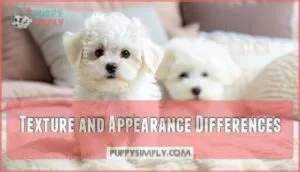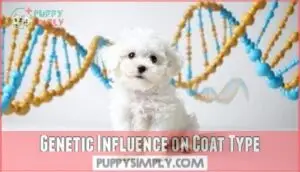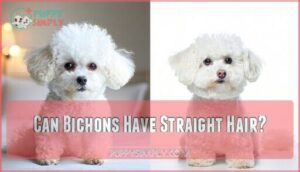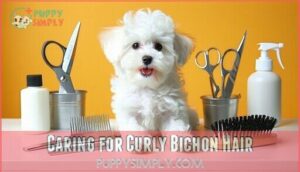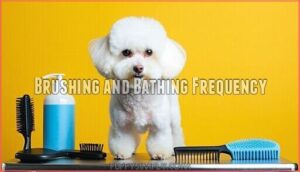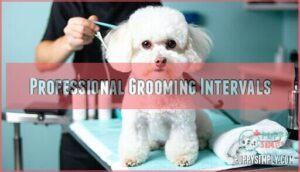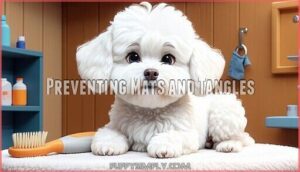This site is supported by our readers. We may earn a commission, at no cost to you, if you purchase through links.
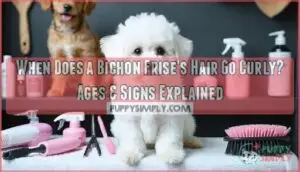
You’ll notice the change gradually as coarser, more textured strands replace that cotton-ball fluff. Daily brushing becomes your best friend during this phase since those emerging curls love to tangle. The timing varies between pups, but most show clear curl patterns by their first birthday.
Understanding this natural progression helps you prepare for the grooming marathon ahead and decode the mysteries behind your Bichon’s evolving coat personality.
Table Of Contents
- Key Takeaways
- When Does a Bichon Frise’s Hair Go Curly?
- Bichon Puppy Coat Versus Adult Coat
- What Determines if a Bichon’s Hair Will Be Curly?
- Can Bichons Have Straight Hair?
- Caring for Curly Bichon Hair
- Bichon Frise Coat Maintenance Routine
- Common Coat and Skin Issues in Bichon Frises
- Frequently Asked Questions (FAQs)
- How can I care for a Bichon Frise’s curly hair?
- What are the different Bichon Frise haircut styles?
- Can Bichons have straight hair?
- What determines if a Bichon’s hair will be curly?
- When does a Bichon Frise’s hair go curly?
- How often should I brush my Bichon puppy?
- What foods help reduce Bichon tear staining?
- Do male and female Bichons have different coats?
- Can stress affect my Bichons coat development?
- Should I trim my Bichon puppys coat early?
- Conclusion
Key Takeaways
- Your Bichon’s hair starts transitioning from soft puppy fluff to a curly adult coat around 3-6 months when the infant coat begins shedding from neck to tail.
- The KRT71 gene determines whether your Bichon develops curly, wavy, or straight hair – most inherit curly genes, but genetics from past generations can surprise you.
- You’ll need to brush daily with a pin brush once curls develop since they tangle quickly, and the full adult coat won’t mature until your dog reaches three years old.
- While rare, some Bichons can have straight hair due to genetic variations, though this doesn’t meet breed standards for show competition.
When Does a Bichon Frise’s Hair Go Curly?
You’ll notice your Bichon’s coat starts changing from puppy fluff to curly adult hair around 3-6 months old.
This change happens gradually as the infant coat sheds from neck to tail, revealing new hair that’ll continue thickening until your pup reaches about 3 years old.
Typical Age for Coat Transition
Your Bichon Frise puppy’s coat transformation begins around 3-6 months old. During this critical period, their infant coat starts shedding from neck to tail, revealing the foundation for their future curly adult texture.
Key Coat Development Milestones:
- 3-4 months: Initial puppy shedding begins
- 6-8 months: Baby coat emerges underneath
- 12-18 months: Curly transformation accelerates
- 24-36 months: Full adult coat maturation
- 3 years: Complete coat development finished
Signs of Coat Change in Puppies
Watch for subtle changes around 3-6 months when your Bichon’s puppy shedding begins. You’ll notice the infant coat texture shifting from neck to tail, revealing shorter hair growth underneath.
This baby coat development creates an uneven coat texture initially. Early curly development appears as tight spirals mixed with straighter sections.
Daily brushing helps with mat prevention during this vital hair growth phase.
Factors Affecting Curl Development
Several genetic factors influence how your Bichon Frise’s curls develop. The KRT71 gene determines curl patterns, while hair follicles respond to hormonal changes during puppy development.
Coat texture shifts as guard hairs thicken and the undercoat densifies. Nutrition, stress levels, and seasonal changes can also affect curl formation.
Each Bichon Frise puppy follows their own timeline—some develop tight spirals while others sport loose waves, making every coat journey unique.
Bichon Puppy Coat Versus Adult Coat
You’ll notice your Bichon puppy’s coat looks nothing like what you expect from an adult—that’s completely normal and part of the breed’s fascinating development process. The soft, often straighter puppy coat transforms dramatically over the first three years, with genetics playing tricks that make even experienced breeders guess wrong about the final result.
Texture and Appearance Differences
Your puppy’s coat will undergo dramatic changes that might surprise you. A Bichon Frise coat transforms from soft puppy fur into the breed’s signature curly coat through distinct phases. Here’s what you’ll notice:
- Coat Texture shifts from silky puppy hair to dense, springy curls
- Hair Growth becomes thicker and more structured over time
- Curl Patterns develop from wavy ripples into tight corkscrews
- Fur Density increases substantially as the adult coat emerges
- Color Variations may appear subtly different as texture changes
Understanding the factors of coat color changes can help you better anticipate your Bichon Frise’s development.
Shedding and Growth Stages
Your puppy’s coat transformation happens in predictable stages. Around 3-6 months, the infant coat starts shedding from neck to tail, revealing new hair underneath. This puppy shedding phase can look patchy but signals healthy hair growth toward adult texture.
| Stage | Age Range | What You’ll See |
|---|---|---|
| Infant Coat | 0-3 months | Soft, fine baby fur |
| Coat Shift | 3-6 months | Patchy shedding, new growth |
| Adult Coat | 18-36 months | Full curly development |
The new baby hair grows thicker until your Bichon Frise reaches full adult coat around three years old.
Genetic Influence on Coat Type
Understanding your Bichon’s genetic blueprint helps decode their coat mystery. The KRT71 gene determines curl patterns through hereditary traits passed from parents. Gene expression affects whether your puppy’s hair growth develops into the characteristic adult coat texture.
- Genetic testing reveals curl potential before adult coat emerges
- Coat inheritance patterns show dominant curly genes usually win
- Undercoat development reflects ancestral DNA influencing final texture
What Determines if a Bichon’s Hair Will Be Curly?
Your Bichon’s curl pattern comes down to genetics, specifically the KRT71 gene that controls whether those adorable spirals will appear.
While you can look at the parents for clues, each puppy’s coat is like opening a surprise package—genetics from past generations can pop up and totally change what you’d expect.
Role of The KRT71 Gene
Your Bichon’s coat texture comes down to genetic variants in the KRT71 gene. This gene controls curl expression through allele combinations – two curl copies create curly coats, while one copy produces wavy hair.
Gene inheritance determines whether your pup develops the signature Bichon Frise adult coat or stays straighter during dog coat development phases. Understanding the dog curly coat genetics is essential for predicting the coat type of your Bichon Frise.
Influence of Parent and Ancestor Coats
While genes control curl potential, you can’t judge your Bichon’s future coat by just looking at mom and dad. **Genetic coat traits skip generations unpredictably.
** Your straight-haired pup might carry ancestral influence from a great-grandparent’s curls.
Parental coat type offers clues, but hereditary factors from previous generations surprise even experienced breeders. **Coat inheritance patterns in Bichon Frise development rarely follow simple rules.
** Understanding the breed history is vital to grasping these complex genetic interactions.
Predictability and Variability in Litters
Even with parent coat information, litter patterns can surprise you. Genetic variance means Bichon Frise puppies from the same parents may develop completely different coat types. One puppy might inherit curly coat inheritance while siblings get wavy or straight hair.
This unpredictability stems from complex gene combinations affecting puppy development. Breed standards expect curls, but Bichon Frise grooming needs vary based on each puppy’s unique coat inheritance pattern.
Understanding the genetics of curly coat traits is essential for breeders to make informed decisions about breeding and selection.
Can Bichons Have Straight Hair?
While most Bichons develop their signature curls, you’ll occasionally find one with straighter hair due to genetic variations in the KRT71 gene.
These straight-coated Bichons are rare but perfectly healthy, though they’ll need different grooming techniques than their curly counterparts.
Occurrence and Genetics of Straight Coats
Sometimes your Bichon Frise might surprise you with straight hair instead of classic curls. Genetic factors like the KRT71 gene determine coat texture through inheritance patterns.
When two copies of non-curly alleles combine, straight guard hairs develop rather than the typical curly Bichon Frise coat. Gene expression affects puppy hair growth, making straight coats rare but possible in purebred lines.
Differences in Maintenance and Grooming
Straight-haired Bichon Frise dogs require different grooming approaches than their curly counterparts. You’ll need fewer specialized grooming tools since straight coat texture creates less hair density and tangles. Regular brushing becomes easier without curl enhancement techniques.
Mat prevention stays important, but straight puppy hair growth means less frequent detangling sessions. Your Bichon Frise still needs consistent grooming, just with modified techniques for their unique coat structure.
Understanding dog behavior traits is also essential for effective grooming and overall care.
Breed Standards and Expectations
While grooming differences matter, breed standards tell the real story. Official Bichon Frise breed characteristics demand curly coat texture, not straight hair. Show dogs must display proper Bichon coat with dense curls and white coat color.
Straight-haired Bichons don’t meet grooming standards for competition. Your puppy development should align with these genetic factors and breed expectations.
Caring for Curly Bichon Hair
Once your Bichon’s curls start developing, you’ll need to step up your grooming game since those adorable spirals love to tangle faster than earphone cords in your pocket. Daily brushing with a pin brush becomes your best friend, followed by thorough combing to catch any sneaky mats hiding beneath that fluffy surface.
Grooming Tools and Techniques
Success with curly coat care starts with the right arsenal. You’ll need a quality pin brush for daily grooming—it works through dense curls without breaking precious hair. Add a metal comb to catch hidden tangles your brush missed. Professional clippers handle trimming, while detangling spray makes stubborn knots surrender.
Choose tools designed for double-coated breeds. For ideal results, using the right curly hair tools is essential for maintaining healthy curls.
Brushing, Combing, and Detangling
When you brush regularly, you’re fighting the good fight against mats. Start with detangling tools like a pin brush to work through your Bichon’s curly coat care routine.
Always brush before you comb—this catches sneaky tangles hiding in that fluffy hair texture. Mat prevention means gentle brushing from skin outward, not just surface fluffing. Follow up with a metal comb for thorough detangling.
Recommended Products for Curly Coats
Now that you’ve mastered brushing techniques, choosing the right products makes all the difference for your Bichon Frise’s curly coat. Quality shampoo types and conditioner sprays work together like a dream team. Regular use of a suitable Bichon shampoo can help maintain the health and appearance of their curly coat.
- Whitening shampoo – Artero Blanc fights yellow undertones with blue pigments
- Conditioner sprays – Keep curls soft and manageable between baths
- Detangling tools – Chris Christensen slicker brush prevents painful mats
- Whitening products – Bio-Groom Super White maintains brightness without bleaching
- Grooming wipes – Quick touch-ups for face and paws
Bichon Frise Coat Maintenance Routine
You’ll want to establish a consistent grooming routine as your Bichon’s curls develop and their coat density increases. Daily brushing with a pin brush and monthly baths with whitening shampoo will keep that fluffy white coat looking its best while preventing painful mats from forming.
Brushing and Bathing Frequency
Your Bichon Frise needs daily brushing to prevent mats from forming in their curly coat. Use proper brushing techniques with a pin brush, working through sections methodically.
Bathing should happen every 3-4 weeks with whitening shampoo to maintain that bright appearance. A consistent bathing schedule paired with coat conditioning prevents tangles.
Quality grooming tools make mat prevention much easier than dealing with painful knots later.
Professional Grooming Intervals
Your Bichon Frise needs professional grooming every 6-8 weeks to maintain proper coat styling and prevent matting. Regular brushing between appointments helps, but skilled trimming techniques are essential for that signature poufy look.
Professional groomers understand Bichon-specific grooming schedules and can adjust haircut styles based on your dog’s coat development. Never attempt shaving at home—it damages their double coat permanently.
Understanding dog grooming techniques is vital for maintaining the health and appearance of your Bichon Frise.
Preventing Mats and Tangles
You’ll want to stay ahead of mats before they become a nightmare. Daily brushing with a pin brush keeps your Bichon’s curly hair care routine on track.
- Daily brushing prevents mats from forming in dense curly coats
- Use detangler spray before brushing to ease tangle removal
- Always follow brushing with a comb to catch hidden knots
- Focus on high-friction areas like legs, chest, and behind ears during regular grooming
Common Coat and Skin Issues in Bichon Frises
You’ll encounter several coat and skin challenges as your Bichon’s curls develop, from tear staining around those adorable eyes to keeping their immaculate white coat looking its best.
Understanding these common issues helps you tackle problems before they become serious headaches for both you and your fluffy companion.
Tear Staining and Facial Hygiene
Despite your best grooming efforts, tear stains can plague Bichon Frise faces like unwelcome house guests. Daily facial cleaning with canine-safe wipes prevents these reddish-brown marks from setting in around Bichon eyes.
Your tear stain remover arsenal should include gentle cleansers and medicated wipes for stain prevention. Effective tear stain removal requires understanding of stain remover products.
| Tear Stain Removal Method | Frequency |
|---|---|
| Daily eye area cleaning | Every day |
| Specialized tear stain remover | 2-3 times weekly |
| Face grooming/trimming | Every 2-3 weeks |
| Professional eye hygiene | Monthly visits |
Ear and Paw Care
How do you keep those adorable ears and paws in top shape? Your Bichon’s ears and paws need special attention to prevent infections and discomfort.
- Ear Cleaning: Use a quality ear cleaner like Aurigel weekly to remove wax and debris
- Ear Infections: Watch for redness, odor, or excessive scratching around ears
- Paw Hygiene: Clean paw pads daily, especially after walks on rough surfaces
- Nail Trimming: Trim nails every 2-3 weeks to prevent overgrowth and splitting
Tips for a Healthy, White Coat
Beyond daily brushing and regular bathing, your Bichon Frise’s white coat thrives with proper coat nutrition and strategic grooming tips. High-quality fur conditioners improve skin health while preventing yellowing. White enhancement shampoos maintain that flawless appearance between professional sessions.
Don’t forget—a balanced diet rich in omega fatty acids works wonders from the inside out.
Frequently Asked Questions (FAQs)
How can I care for a Bichon Frise’s curly hair?
Brush your Bichon daily with a pin brush to prevent matting. Use spray conditioner before brushing. Comb afterward to catch hidden knots.
Bathe monthly with whitening shampoo. Professional grooming every six weeks keeps their signature fluffy look perfect.
What are the different Bichon Frise haircut styles?
Your fluffy white cloud has unlimited hairstyle potential! You’ll choose between classic Show cuts with rounded, fluffy haircuts, practical Puppy cuts, stylish round head cuts, or maintenance-friendly Kennel cuts for different looks.
Can Bichons have straight hair?
Yes, you’ll occasionally find Bichons with straight hair. While most purebred Bichons carry curly genes, some inherit straight-hair genetics from previous generations, creating surprisingly sleek coats instead of trademark curls.
What determines if a Bichon’s hair will be curly?
Your Bichon’s curl factor comes down to genetics, specifically the KRT71 gene variants.
Dogs carrying two curl alleles (C1/C1, C2/C2, or C1/C2) develop distinctly curly coats, while single copies create wavy hair instead.
When does a Bichon Frise’s hair go curly?
Like watching a flower bloom, your pup’s curls gradually emerge between 3-6 months as their infant coat sheds. The new baby hair grows thicker and curlier until they reach their full adult coat around three years old.
How often should I brush my Bichon puppy?
You’ll want to brush your Bichon puppy three times weekly initially, then daily as their adult coat develops. This prevents painful mats from forming in their increasingly dense, curly fur.
What foods help reduce Bichon tear staining?
Feed grain-free, dye-free foods without artificial additives. Avoid kibble with dyes and highly processed foods, as excess minerals like iron can darken tears. Use filtered water to prevent staining.
Do male and female Bichons have different coats?
Notably, 100% of Bichon genetics determine coat texture regardless of gender. You won’t find differences between male and female coats—both sexes develop the same curly, dense double-coat structure through identical genetic pathways and hormonal influences.
Can stress affect my Bichons coat development?
Stress can definitely affect your Bichon’s coat development. High stress levels may delay curl formation, cause thinning, or create patchy texture changes during the critical development phases.
Should I trim my Bichon puppys coat early?
You shouldn’t trim your Bichon puppy’s coat early. The infant coat naturally sheds from 3-6 months, revealing the adult coat underneath. Early trimming won’t speed this process and may interfere with natural development.
Conclusion
Watching when does a bichon frises hair go curly unfold is like witnessing the world’s fluffiest metamorphosis. You’ll see those first telltale spirals emerge between 3-6 months as nature swaps out that puppy softness for adult texture.
The transformation continues until age three, guided by genetics and requiring your dedicated brushing commitment.
Remember, every curl tells a story of your Bichon’s unique coat journey, making daily grooming an investment in their signature look.
- https://allgroom.co.nz/blogs/breed-guides/ultimate-bichon-clippers-grooming-guide
- https://www.reddit.com/r/bichonfrise/comments/1g1bbqe/hi_when_will_the_coat_be_better/
- https://bichon.org/about-bichons/breed-info/grooming-tips/
- https://www.trainpetdog.com/breed/Bichon-Frise/
- https://vgl.ucdavis.edu/test/curl

